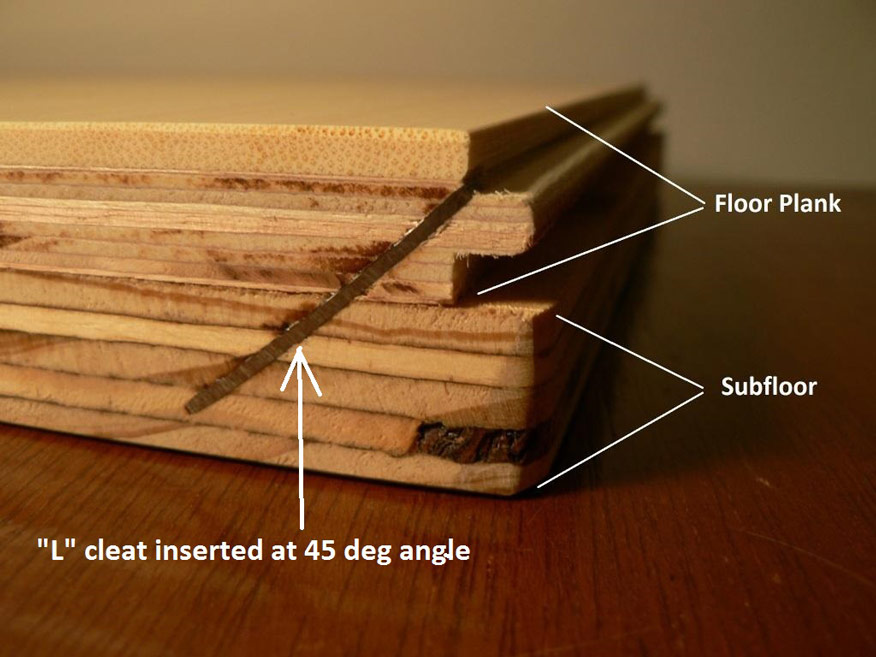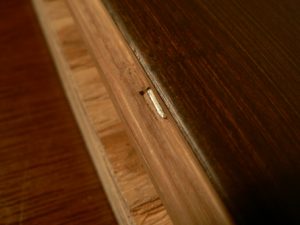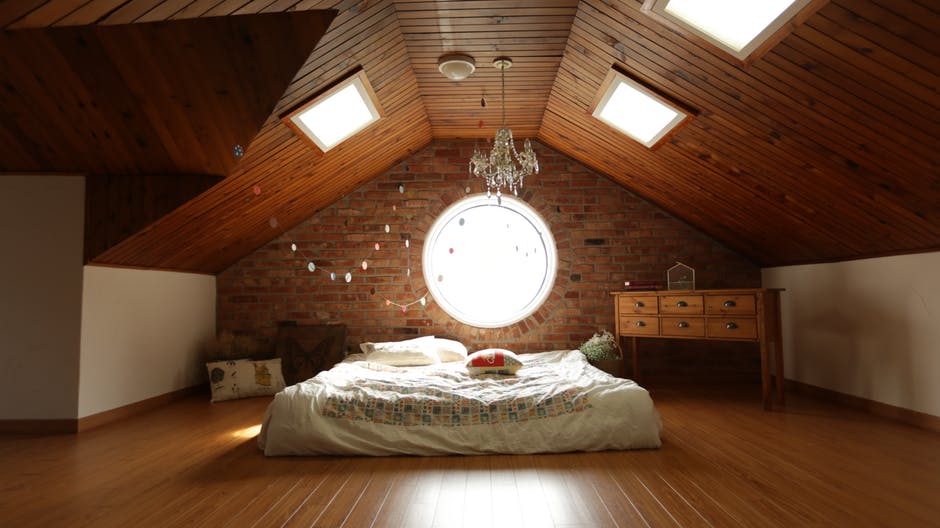A common installation question we get every week is, “I’ve heard it’s super dense – can I nail down bamboo flooring?”
The answer is a definitive YES. In fact, thousands of people worldwide nail down strand woven bamboo floors every day; it’s the most common installation method. However, like with anything in life, you have to make sure you have the right tools.
This topic is critical because a bamboo floor that is properly installed can easily last a lifetime, even under the heavy foot traffic that comes from having an active family and rambunctious pets.
Installation methods
First of all, there are 3 common methods used to install hardwood and bamboo flooring. Each has its own pros and cons, but today, we’re going to look at the nail-down method.
Please note: In this article, we’re going to focus on which Janka tests show is the hardest wood flooring on the market, by far.
Which installation method? Nail, glue, or float?
There are a few different factors that can affect your installation method. First, you need to consult your bamboo flooring manufacturer’s installation instructions, as disobeying these could void your warranty.
Other than that, there are some simple rules to help you decide which method is best for you:
- Gluing down the floor is the most stable installation because the glue’s elasticity allows the floors to expand and contract naturally with the seasons. The glue provides some sound insulation. However, gluing down is also the most expensive and messiest of the methods.
- Nailing down the floor is great when you have plywood or a suitable sub-floor (more on that below), and you want it done quickly and inexpensively. Nailing down is probably the most common way that hardwood flooring (including bamboo) is installed. The one drawback is that after 5-10 years of seasonal cycles, the cleats/nails can come loose and squeak a little.
- If you’re installing the floors in areas with long runs (generally over 30 feet long), then you should either nail down or glue down your floors.
- If the room has cumbersome furniture, you should either nail down or glue down the floors. Alternatively, you could also take the opportunity to get rid of the unwanted 1930s furniture that you inherited from your in-laws.
- If you’re installing the floors yourself, the floating method using click lock bamboo flooring is the easiest method for DIY-ers to tackle.
- If the sub-floor is concrete, then you won’t be able to nail down the floors; you’ll be required to glue down or float. Shockingly, putting nails into concrete is hard work. It’ll generally just leave you with busted nails, damaged flooring planks, and a sore wrist.
So, how do I nail down a bamboo floor? First, plan.
It’s actually a straightforward process, but it does involve some all-important prep-work and a little bit of patience. Let’s go through it step-by-step.
There are a few things that you’ll need to go over before beginning, like checking whether your sub-floor is suitable for nailing (and it will actually hold the nails/cleats) and allowing the bamboo to acclimate to the room that it’s being installed in. Failure to acclimate a wood floor can cause problems right away or further down the line, like cupping due to humidity. Manufacturers don’t accept responsibility for these mistakes, and it could be quite a costly error for you.
Ordering and receiving the bamboo flooring
- Order 7-10% more bamboo flooring you measured for: This will account for cutting and waste.
- Check the warranty and installation guide: Does it say not to install in a basement? Or in an unconditioned room (i.e., garage)? Or overheated sub-floors? What are the acceptable sub-floor types? Abide by the warranty to protect your consumer rights.
- Inspect for shipping damage at the time of receipt: although most manufacturers take the utmost care during selection and shipping, mistakes can happen. Avoid using any plank with visible defects, report it to the manufacturer, and carefully check their returns policy. The shipping damage usually looks worse than it is. Most of the damaged planks can still be used for starter rows, so accept the shipment but make sure to record the damages on the driver’s bill of lading. The shipper can send you free replacement materials.
- Set aside one plank to test your cleaning agents on. This will ensure that you don’t have planks with damaged finishes in the center of your living room, where your mother-in-law will be sure to comment on them.
How sub-floors can affect your installation
In some cases, it will be impossible to nail down a bamboo floor because of the existing sub-floor (i.e., concrete, vinyl tiles, particle board) or the sub-floor placement (i.e., below grade). If that is true for your sub-floor, then you’ll have to use another method, like gluing or floating.
What sub-floors are good for nailing?
Many types of sub-floor can accommodate the nailed down installation method, including:
Advantech OSB
- Plywood, which is 5/8” thick or more, except Luan
- Existing wood floors, which are 3/4” thick or more
- Firm linoleum, if over plywood.
- Firm kitchen vinyl, if over plywood.
Once you’ve established that you can nail down your bamboo flooring, it’s time to prep your sub-floor.
How do I prep a sub-floor for the installation of a bamboo floor?
A few things are essential to do to get your sub-floor ready for installation, but it’s a relatively simple list. Here’s what you do:
- Clear the room: This means removing all furniture – because you can’t install your floor around a couch – but it’s also a good idea to remove things like hanging pictures and curtains to keep everything as clean as possible.
- Clean the room: Sweep the sub-floor to remove all dirt and debris (i.e., dust, crumbs, broken accessories from your child’s dolls or action figures) because you don’t want that getting stuck under the floorboards.
- Ensure the floor is dry: If the sub-floor is emitting moisture, this can cause all sorts of problems from mildew growth to buckling boards. Test your sub-floor using a moisture meter, and remember that a wood sub-floors acceptable moisture content is 12% or less.
- Ensure the floor is level: The floor grade should vary by no more than 3/16″ per 10-foot radius. You can sand down high spots and fill in low spots using a self-leveling compound or similar, as you can see in the video below.
Address potential moisture problems in crawl spaces
Whilst we’re on the subject of things you need to do before installing your bamboo floors, let’s talk about it. Do you have one? If so, you’re going to need to make sure it’s dry and well-ventilated before installing your floors.
If you’re anything like us, you’re slightly scared of doing anything in your crawl space if it turns out someone is living in there. However, if you don’t remedy any moisture problems in your crawl space, you could deal with buckling boards in the future.
So grab a trusted friend, a flashlight, and remember that the chances of running into someone else in your crawl space are fairly small unless you live in a horror film. The most common method for dealing with a humid crawl space is to add vents, install tarps, install a dehumidifier, or use a large fan, which you can learn more about here.
How to acclimate your bamboo floor to the room
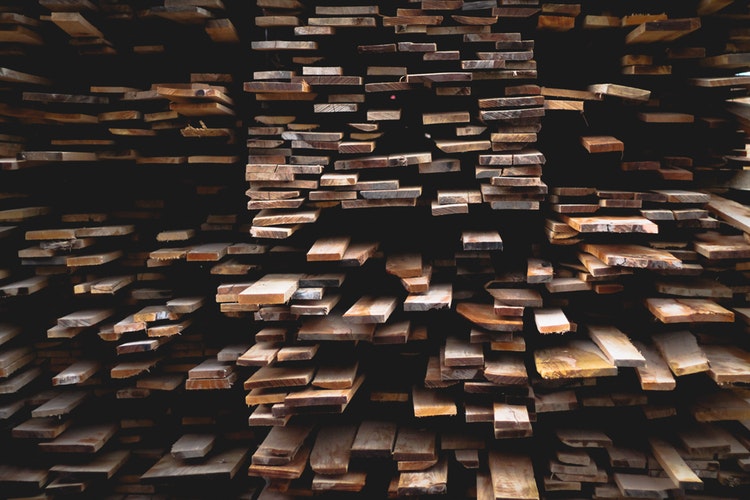
To properly acclimate, you will need to clear and clean the room that the floor will be installed in. Then, close all of the windows and doors to the room and cut open the boxes as per the installation guide.
You’ll want to acclimate the floor for at least 3 full days while keeping the room’s temperature and humidity to normal year-round levels. Most recommend a temperature of 60-80 degrees Fahrenheit and humidity of 40-60 % but always check your specific guidelines.
Important: Don’t cover the planks in paper or plastic or they could discolor and/or suffer from moisture problems. Also, never acclimate the floors over concrete or an unsealed crawl space, as doing so could result in the floors absorbing excessive moisture and then cupping later.
If this room is one that your family needs to use regularly (i.e., bathroom or kitchen), why not leave the boards to acclimate while you take a vacation? You’ll be the family hero, and you won’t have to eat, take out or use the neighbor’s shower every night for a week. Win-Win.
What tools will I need to nail down a bamboo floor?
Many tools are helpful while nailing down bamboo floors, but while some of them will need to be bought, others can be rented from big box stores or borrowed from kindly friends and family. After all, you need to save your money for that vacation you planned in the last section.
The most important tools for nailing down strand woven bamboo:
- High Powered 18 Gage Pneumatic Floor Nailer **We highly recommend the Primatech Q550 ALR. It’s the best bamboo flooring nail gun but can sometimes hard to find, so rent it from the same company you get your floors from if you can.
- Tape measure
- Chalkline
- Rubber mallet
- Table saw
- Mitre saw
- Tapping block made of wood/hard rubber
- Oscillating saw (to cut door frames, if needed)
- Carpenter’s square (length depends on the thickness of sub-floor)
- 15 lb asphalt-saturated felt paper or red rosin paper (make sure it’s the newer versions that meet/exceeds your manufacturer’s standards)
- Minimum 40 tooth min. saw blade (if possible, get a higher tooth count diamond carbide blade – it equals a cleaner cut)
- 23 gauge micro pin nailer (to work around islands/install perimeter moldings)
Time to start nailing
After making sure your sub-floors are level and dry, acclimating your floor properly, and collecting your installation tools, you should first lay down 15 lb asphalt-saturated felt paper or red rosin paper evenly across the sub-floor to ensure full coverage and no bumps from overlapping sections.
After that, you should check that the is both clean and well-oiled to avoid any jams during installation, which could cause damage to the floorboards or you!
Once you’ve made sure that the machine if ready-for-use, take a spare bamboo plank to test the pressure needed for installation, which will vary based on plank thickness and machine type, too little pressure, and the nails won’t go through the board, too much and they could split the board.
Getting the bamboo out
It would help if you always worked out of 4-6 boxes to ensure you’re getting balanced color variation throughout the floor and don’t end up with any shade patches.
As bamboo planks are a natural product, there will be color and shade variations from box to box, and indeed, each plank means that you can fully customize your floor to your tastes. Think some planks are too dark? Leave them out.
It’s advised that when you start cutting the planks down to size, you cut varying lengths (none less than 8”) to ensure that the butt ends of the planks in adjoining rows aren’t too near to each other. Here’s a helpful video where you can watch a quick summary of a nail down installation from start to finish:
Tips and Tricks For Successfully Nailing Down a Bamboo Floor
When faced with any big job, it can feel overwhelming, which is why you need to break down the process. Otherwise, you’re just as likely to put your head in your hands and give up!

1. Choose where to lay the first row
You are the only person who can decide the best place to start, and it will depend on the room layout and how the flooring interconnects between the other rooms.
If the room is square, you could start to install parallel to the longest wall, but if the room isn’t square, you may choose to in the middle of the room – which, yes, sounds counter-intuitive– to ensure that there is a straight line of flooring in a visible area.
If the room is not square, the flooring planks’ run can be broken and corrected at doorways using at-molding.
2. Leave expansion space between the base plate/wall
You need to leave between ¼ and ½ of an inch between the bamboo flooring planks and the base plate or wall so that there is room for the boards to expand in the case of excess humidity. If you do not leave this space, the boards could buckle/bow, and a repair can be costly.
Don’t worry about this gap being visible; the shoe molding or baseboard hides it.
3. Make sure that your starter rows are firmly in place
If your first row of planks isn’t properly in place, this will cause all sorts of problems later on because you won’t be able to lay succeeding rows in a straight line. How do you establish a straight line? Find the midpoint between the walls (make sure to include expansion space) and mark the line.
It would help if you also nailed the starting/finishing row through the plank’s tongue at a 45-degree angle. If you cannot do this, then you should either glue it with a urethane adhesive or pre-drill the hole and screw the nail in. Pro Tip: Use your sacrificial plank to test out your method and use wood putty to fill in nail holes.
4. Nail down the next few rows
Once you’ve installed the first row, it’s a super simple process to install the others as you already have the guidelines. When using fasteners, space them out at intervals of 8-10” with a minimum of six fasteners per plank, and don’t place them within 3” of the end of each board.
Make sure to use gentle, consistent taps on the pneumatic nailer – if you’re too firm, you can knock the rows out of place (and probably kick yourself for it!) – and blind nail them directly above the tongue at a 45-50 degree angle to the face of the plank (the side facing up).
5. Check for Dimples! You may not have set the bamboo flooring nail gun up properly.
We don’t mean the dimples on your face – we mean tiny bumps in the floor! These dimples are not only a cosmetic problem: they could eventually cause structural problems in the planks or finish stability.
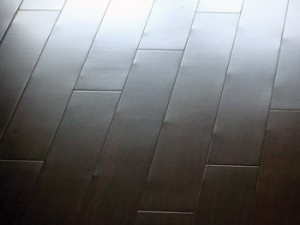
Sometimes these dimples are hard to spot when standing directly over them, so make sure to check your floor by looking at it from an angle, with some glare shining on the surface from a background light or window.
If you see dimples, it means the cleats are not embedded properly and that you’re using the wrong type of nail gun, the size of the cleat, or that your nail gun pressure (PSI setting) is too low.
If you’re having trouble getting the cleats to set properly, check the following:
- Check that your bamboo flooring nail gun is definitely an 18 gauge pneumatic nailer and that it is successfully firing 18 gauge cleats.
- Inspecting the nailer for any signs of damage (i.e., air leaks, wear marks, holes) could affect its performance.
- Ensure that the nailer is seated properly and that the operator isn’t leaning it forward when nailing.
- Increase the PSI setting on the gun.
Still struggling to set the nails properly? Bear this in mind: thousands of strand woven bamboo floors are nailed down every day around the globe with no problem. You may need to change out your nail gun for a Primatech Q550 ALR.
- Check that your bamboo flooring nail gun is definitely an 18 gauge pneumatic nailer and that it is successfully firing 18 gauge cleats.
- Inspecting the nailer for any signs of damage (i.e., air leaks, wear marks, holes) could affect its performance.
- Ensure that the nailer is seated properly and that the operator isn’t leaning it forward when nailing.
- Increase the PSI setting on the gun.
A properly set staple/cleat
If you’re still struggling to set the nails properly, bear this in mind: thousands of strand woven bamboo floors are nailed down every day around the globe with no problem. You may need to change out your nail gun for a Primatech Q550 ALR.
If you switch to another nail gun and still have installation problems, we recommend contacting a local flooring expert or an installer certified by the National Wood Flooring Association.
6. Remove expansion spacers and install moldings
Once you’re done installing all planks, it’s time to remove the expansion spacers you used earlier and cover the gaps with base/quarter-round moldings (or a mixture of the two).
Please note it is difficult to install bamboo moldings using a nail gun (and trying may drive you crazy), so most manufacturers will recommend that you try one of the following alternative methods:
- Glue the moldings in using a moisture-resistant adhesive and leave a heavy object on top of the molding for at least 8 hours (you thought you’d never use those encyclopedias)
- Pre-drill the moldings and nail them into place
- Use a micro-pin nailer such as a Bostitch Porter 23 Gage Micro Nailer.
What to do after your installation is complete.
Well done on completing your installation! The first thing you should do is vacuum the floor to get rid of any dirt/debris (i.e., dust from the nailing), but the second thing you should do is make yourself a well-earned coffee cup (or something stronger if you’re over 21).
Also, make sure to save some offcuts from the floor as this will allow you to test future cleaning products without damaging the laid floor. It’s also handy for testing out new finishes of varnishes to see what they’d look like without sanding and varnishing your whole room.
If you have any larger (or even full size) planks leftover, save extras if you ever need replacement boards. This might be needed because of damage caused by localized flooding (i.e., a burst pipe) or stress (i.e., some rude person dropping a bowling ball on your floor).
Caring for your bamboo floor
While your beautiful bamboo floors are incredibly strong – a massive three times harder than hardwood – you still need to make sure that you’re caring for them properly to make them last as long as possible.
How?
- Put a mat under rolling office chairs.
- Clean the floors regularly to remove grit and dirt
- Buy a scratching post for the cat.
- Put floor protectors on the legs of chairs, tables, sideboards, etc.
- Use vacuum cleaners without abrasive rotary brushes
- Institute a ‘shoes off’ rule at the front door
- Clear up any spills within 20 hours
- Put appropriate mats inside and outside of doors leading outside.
How do I clean my bamboo floor?
Bamboo floors are designed to be deficient maintenance, which means that cleaning will often involve a quick sweep or vacuum. For more intense cleaning, you should only ever use it.
Cleaning with harsh chemicals or wet mopping or steam cleaning can damage the finish, which is supposed to make the floor look nice, protect the floor from water and moisture, and void your warranty.
How do I fix scratches on my bamboo floor?
Your bamboo floor should stand up to decades of everyday wear and tear, but in certain circumstances, you may find light scratches on your floor. Probably from that time, your neighbor insisted on keeping her heels on in your house or when your kids were playing with the dog inside.
If these are minor enough, you could try buffing them out with a soft cloth and some appropriate floor cleaner, but if they are deep enough, then you may have to use floor putty, replace the damaged board, or refinish the floor altogether.
Now I’d like to hear from you. Have you nailed down a bamboo floor? How did it go? Let me know in the comments.
Last Updated: 1/18/2022

About the Author
Meet Bridgett, your friendly neighborhood green building guru! With more years of experience than she’d like to admit, Bridgett is your go-to expert for all things eco-friendly construction. She’s on a mission to make your home the envy of every tree hugger in town (and maybe even the squirrels 🐿️). Let’s build a greener, funnier, and all-around better world together – one enlightened eco-conscious choice at a time!

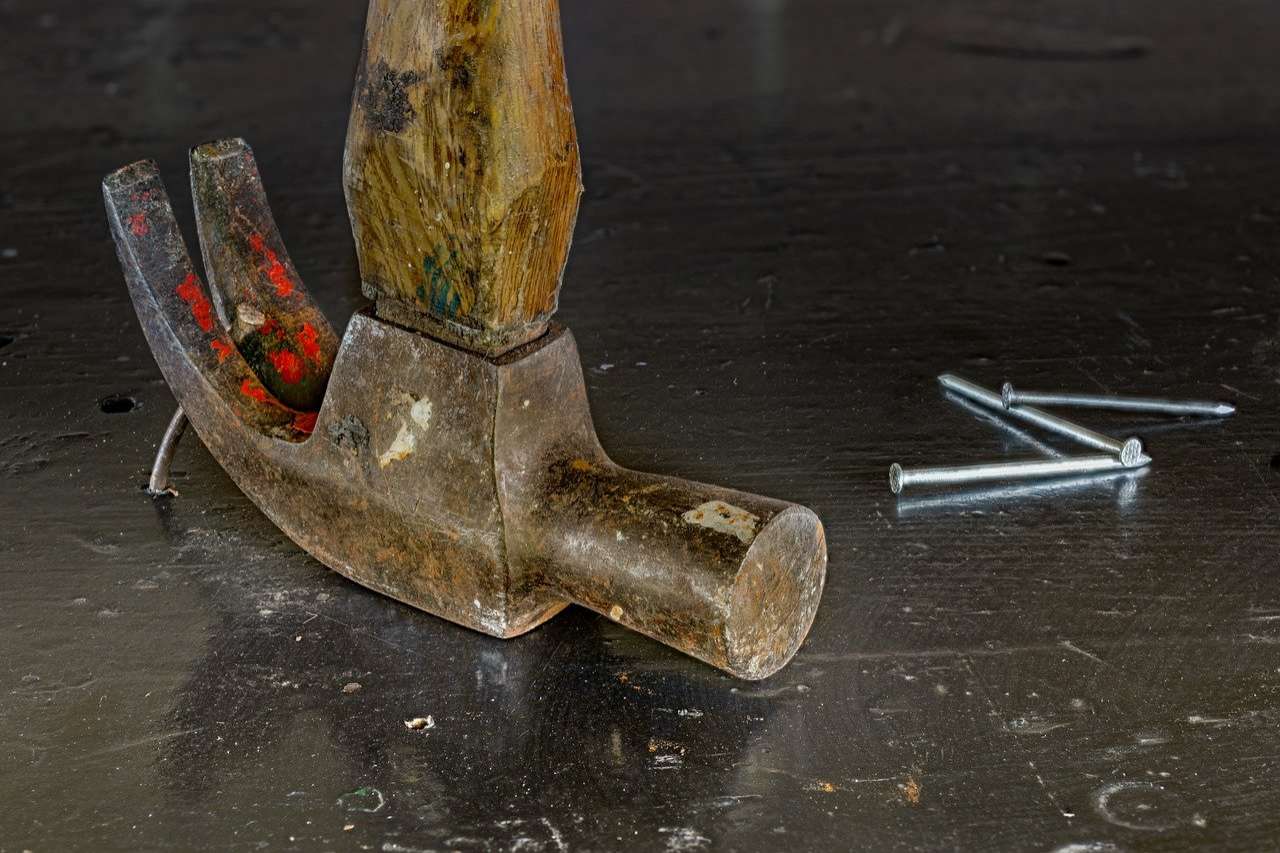
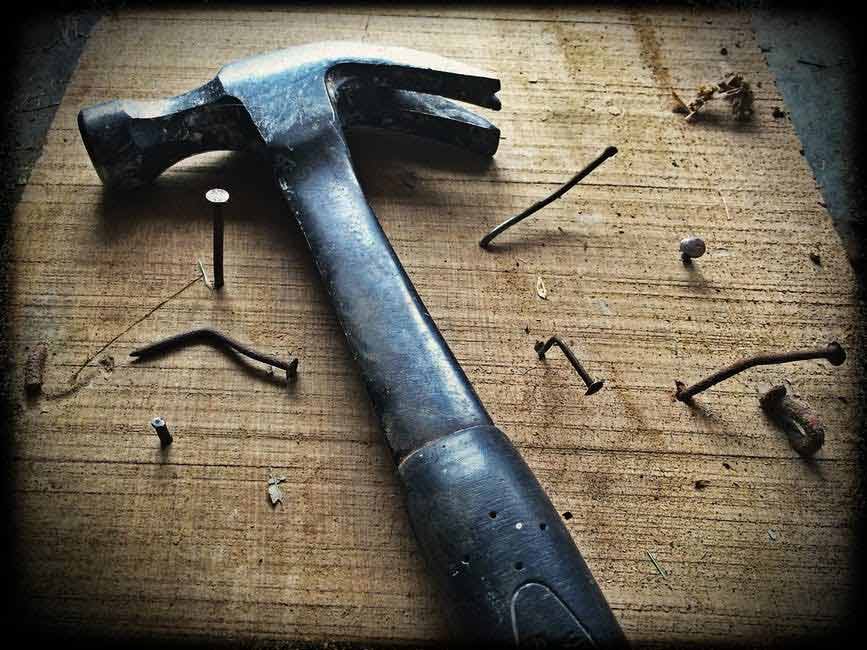
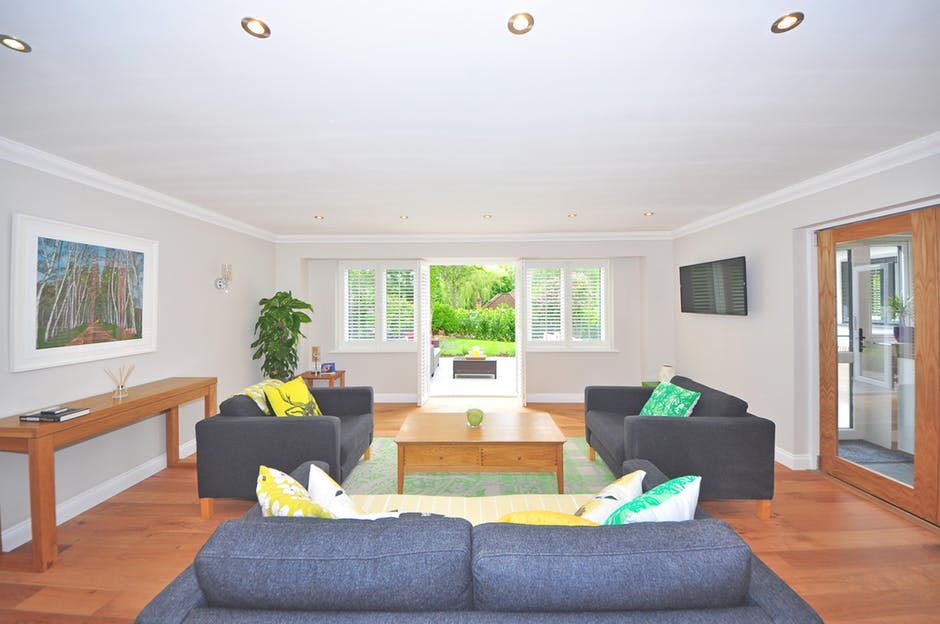
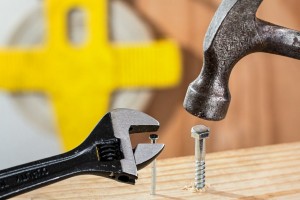 Advantech OSB
Advantech OSB
